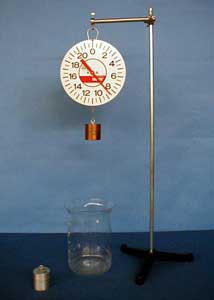Demos: 2B-08 Buoyant Force

Two cylinders, identical in volume but having significantly different masses, are submerged completely in a large beaker of water, one at a time. The cylinder is suspended from a spring scale. Although the actual indicated weights, in and out of water, are larger for the more massive cylinder, the difference in weights is the same for each, because each displaces the same volume of water.
Directions: No special instructions needed. Simple show the class the weight of the cylinder in air, then submerge (without touching the bottom of the beaker) the cylinder and note the apparent weight. Do this for each cylinder.
Suggestions for Presentation: Hang each cylinder from the scale and have the students note the big difference in the two weights. Ask them which would have the greater buoyant force, if completely submerged. Many will say the more massive one, although some may guess the less massive one because it “floats better.” Then remind them that the buoyant force is the difference in the two weight readings. Carefully show that this is the case, then ask why. Some will likely notice that the volumes are the same. This demo reinforces the idea that the buoyant force has nothing to do with the material of the object displacing the fluid. Only the volume of fluid displaced matters.
Applications: Boats can be made from a variety of materials, but they must be shaped in such a way as to displace enough water to support the weight.
Last Updated: Nov 30, 2023 11:25 AM